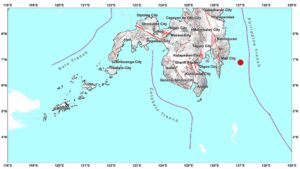Davao Oriental 7.4 quake linked to Philippine trench, unrelated to recent tremors

The magnitude 7.4 earthquake that struck offshore of Davao Oriental on Friday morning was generated by the Philippine Trench and is not connected to the recent tremors that occurred in Cebu and La Union, according to the state seismology agency.
“Okay, so we’re not seeing any pattern. Again, these are all normal activities. The Philippines is very geologically active, and we have more than 180 active fault segment,” Teresito C. Bacolcol, director of the Philippine Institute of Volcanology and Seismology (PHIVOLCS), said in both mixed English and Tagalog in a press briefing on Friday.
“We also have six trenches, and there’s always the possibility of earthquakes occurring one after another,” he added.
The Philippine Trench is one of the country’s six most active trenches, located along the eastern seaboard of Visayas and Mindanao.
Mr. Bacolcol said that throughout its history, the trench has generated several earthquakes above magnitude 7 along the area, notably the magnitude 8.3 event in 1924.
Meanwhile, the separate tremors that occurred in La Union on Thursday morning were caused by distinct tectonic movements, Mr. Bacolcol said, while the destructive quake in Cebu on September 30 was triggered by the newly named Bogo Bay Fault.
“The activity of one fault will not trigger or induce the activity of the other. So they are not related,” Mr. Bacolcol said.
Following the successive earthquakes, the director urged the public not to panic or fall for unreliable earthquake predictions often posted online, noting that no technology currently exists that can accurately predict earthquakes.
“So instead of panicking or giving in to fear, we have to prepare,” Mr. Bacolcol said.
PHIVOLCS lifts all tsunami warning
As of 1:43 p.m., PHIVOLCS had lifted all tsunami warnings it earlier issued for coastal areas of Davao Oriental and nearby provinces following the earthquake.
PHIVOLCS recorded a tsunami wave height of only 30 centimeters at the Tandag, Surigao del Sur Sea Level Monitoring Station at 10:20 a.m. Mr. Bacolcol said this wave height is not considered destructive.
However, aftershocks continue to occur, with PHIVOLCS recording more than 179, ten of which were felt.
The agency reminded the public that aftershocks are expected to persist in the coming days and weeks, ranging from magnitude 1.3 to 5.8, and possibly reaching up to magnitude 6.4. — Edg Adrian A. Eva



















